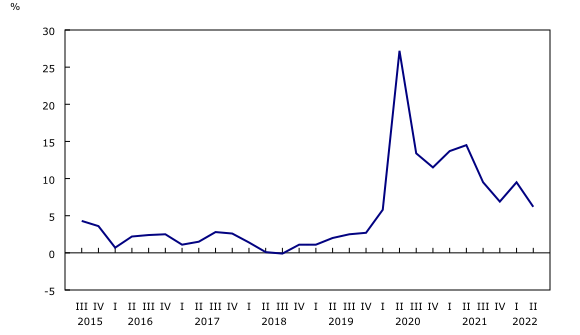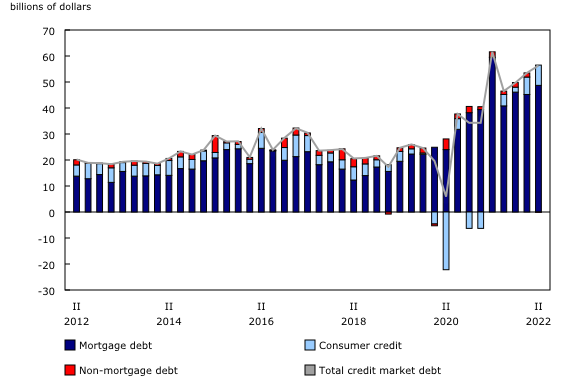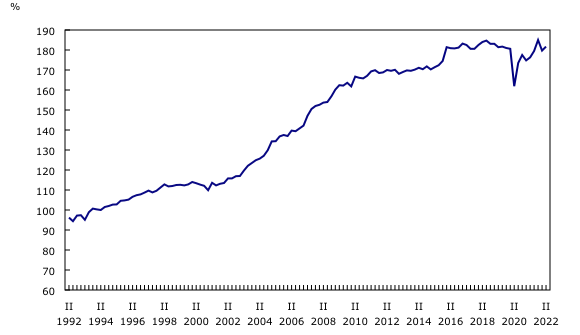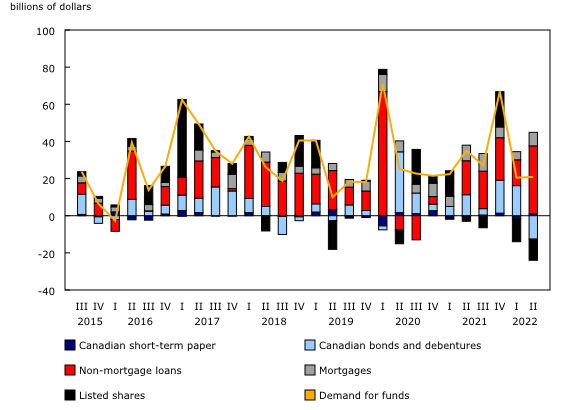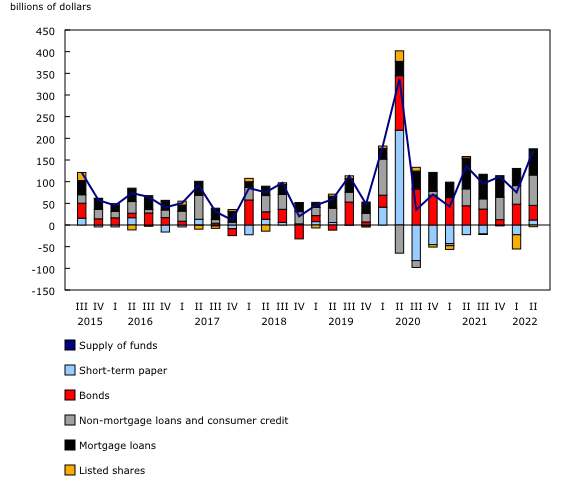National balance sheet and financial flow accounts, second quarter 2022
Released: 2022-09-12
National net worth rises amidst declining international investment position and housing prices
National net worth, the sum of national wealth and Canada's net foreign asset position, edged up 0.2% in the second quarter to $17,646.3 billion, expanding at the slowest pace since the first quarter of 2020 and ending the string of strong quarterly growth that saw Canada's national net worth climb by over $5.1 trillion since the end of 2019. By comparison, an increase of this magnitude took nearly a decade to materialize prior to 2020. Significant declines in both the value of real estate and Canada's international investment position were counteracted by the continued expansion of natural resources wealth. National net worth per capita was nearly unchanged from the first quarter of 2022, edging up to $455,401 in the second quarter.
Highlights
On a nominal basis, the Canadian economy expanded rapidly in the second quarter as the gross domestic product (GDP) implicit price index was at its highest since the mid-1970s. Growth in real GDP was mainly driven by increased business investment and household spending, particularly investment in inventories and outlays on services and semi-durable goods respectively.
Despite rising household incomes, the savings rate fell in the second quarter due to strong nominal household consumption both in terms of increasing volume and prices. Mortgage borrowing by households remained strong in the second quarter although housing demand softened as the Bank of Canada increased the policy interest rate to 1.50% in the second quarter. There was a further increase in the policy interest rate, to 3.25% by September 2022.
In an environment of economic uncertainty including high commodity prices, persistently elevated inflation, continuing disruptions to supply chains, and rising interest rates, both bond and equity markets felt the squeeze. Bond prices continued to decline, and equities shed value across both domestic and international markets amidst expectations of further rate increases.
The federal government continued to borrow through the issuance of long-term debt, albeit at a slower pace as several notable targeted federal government support programs concluded during the second quarter. The Bank of Canada continued to reduce the size of its balance sheet and began its quantitative tightening program.
The total value of non-financial assets in Canada, also referred to as national wealth, increased 1.7% to $16,771.1 billion in the second quarter. The value of residential real estate fell $446.3 billion to $8,655.6 billion, the first decline in value since the fourth quarter of 2018 and a marked slowdown from the $344.0 billion rise in the first quarter of 2022 as the housing market continued to cool amidst rising borrowing costs. Continued pressures on supply chains resulting from Russia's invasion of Ukraine placed upward pressure on global commodity prices, as the value of natural resources in Canada (excluding land) jumped 31.2% from the first quarter to reach $2,407.2 billion in the second quarter. Since the start of 2022, Canada's natural resource wealth has grown by almost one trillion dollars.
Canada's net foreign asset position, the difference between Canada's international financial assets and international liabilities, was down by $230.2 billion to $875.1 billion at the end of the second quarter. This was the second significant quarterly decline in a row. Both international assets and liabilities decreased substantially in the second quarter as global equity markets fell sharply. In the first half of 2022, Canada's net foreign asset position fell by $627.6 billion, from the record high reached at the end of 2021.
Household savings rate declines as spending increase
In the second quarter, seasonally adjusted household compensation grew by 2.0% following a rise of 3.8% in the first quarter. On the other hand, lower transfers received from government (i.e., employment insurance and other benefits) coupled with higher transfers paid to government weighed on income gains. As a result, household disposable income rose 1.0% in the second quarter. At the same time, seasonally adjusted household consumption rose by 4.3% in nominal terms as an increase in the volume of real expenditures was significantly bolstered by price increases across the majority of consumption components, including food and non-alcoholic beverages and furniture and other furnishings. Overall, consumption outpaced disposable income in the second quarter, which pushed household net savings lower. The savings rate fell to 6.2% in the second quarter from an upwardly revised 9.5% in the first quarter. By comparison, the average savings rate over the decade prior to 2020 stood at 3.4%.
Households sell off mutual fund shares after recording record inflows since the end of 2020
Household net savings represent a source of funds that are available to increase non-financial and financial wealth through the purchase of assets and settlement of liabilities. After posting record levels of net inflows into mutual funds and exchange traded funds over the preceding six quarters, including a record inflow at the end of 2021, the tables turned as households recorded $11.0 billion in net redemptions of mutual funds shares in the second quarter of 2022.
Households added $41.9 billion of total currency and deposits in the second quarter, as their holdings of this asset neared the $2 trillion mark. With rising interest rates, households have been shifting their preferences towards fixed-term deposits such as guaranteed investment certificates. Higher returns combined with the relative security of fixed-term deposits is likely increasing their attractiveness to household depositors compared with other types of investments that are currently subject to more uncertainty.
Households' net worth declines as households face trifecta of market challenges
Household sector net worth—the value of all assets minus all liabilities—dropped $990.1 billion in the second quarter to $15,215.3 billion, a decline of 6.1% from the first quarter. The contraction in household wealth was the largest decline on record as households were faced with challenging equity, bond, and housing markets, all of which pointed to lower asset valuations. This deterioration followed a period of strong growth beginning in early 2020 during which households saw their wealth rise significantly on ebullient housing and financial markets.
The value of households' total financial assets fell for the second consecutive quarter, dropping by a record $530.6 billion in the second quarter as market turmoil broadened. This decline was compounded by a $389.8 billion drop in the value of non-financial assets, as the streak of gains in real estate that began in late 2018 was halted by a housing market grappling with rapidly rising interest rates. Financial liabilities increased by $69.8 billion during the second quarter of 2022 due to the continued expansion of outstanding mortgage debt and a rise in consumer spending, which fueled growth in non-mortgage debt.
Residential real estate values fall while borrowing costs continue to climb
The value of household residential real estate declined by 5.0% in the second quarter, more than erasing the gains from the 3.9% increase in the first quarter, but remained more than $2.3 trillion or 41.1% higher than the level recorded at the end of 2019. The value of residential land declined 8.7% in the second quarter of 2022, while residential structures posted a modest increase (+1.0%) as housing investment moderated in the quarter. The average resale price dropped by 10.5% from the first quarter to reach roughly $710,000 in the second quarter, while home resale inventory levels increased on a seasonally adjusted basis but remained at lower-than-average levels. By July, the average resale price dropped further to $635,000. On a year-over-year basis, there were 24.1% fewer home sales recorded in the second quarter, while the second quarter of 2021 saw the highest level of home sales on record.
Real estate as a percentage of household disposable income, an indicator of housing affordability, declined for the first time since the second quarter of 2020, reaching 546.7% in the second quarter of 2022; this compares with 581.3% from the first quarter of 2022 and 449.0% at the end of the fourth quarter of 2019.
Household financial assets hit by weaker equity and bond markets
The value of household financial assets tumbled by 5.7% in the second quarter, pulled down mainly by the depreciating values of debt and equity securities. Household wealth held through institutional investors such as mutual funds and insurance and pension plans shed a record $429.2 billion in value by the end of the second quarter compared with the first quarter, mainly as a result of downward revaluations (-$436.5 billion). This was the second consecutive quarterly decline in the market-value of these investments.
The Toronto Stock Exchange composite index (TSX) dropped 13.8%, following a 3.1% increase in the first quarter. By comparison, the Standard and Poor's 500 (S&P 500), which is more weighted towards technology companies, dropped 16.4% in the second quarter, the second consecutive quarterly decline.
Also impacting financial asset values, bond prices recorded another significant drop in the second quarter, following a substantial decline in the first quarter, as yields for debt securities climbed higher. Higher interest rates generally translate into higher bond yields, meaning lower prices for fixed income securities. The second quarter marked a less common occurrence when both bond and equity markets declined substantially.
Household borrowing reaches near record pace
On a seasonally adjusted basis, the pace of credit market borrowing accelerated from the first quarter, with households adding a near record $56.3 billion of debt in the second quarter. By comparison, households borrowed a record $61.6 billion in the second quarter of 2021, fueled principally by unprecedented demand for mortgages. Mortgages remained the largest contributor to the heightened market borrowing in the second quarter of 2022 with demand of $48.7 billion, while demand for non-mortgage loans posted two consecutive quarters of heightened activity (+$8.3 billion in the first quarter and +$7.7 billion in the second quarter) not seen since early 2018.
In terms of new residential mortgage funds advanced by financial institutions, which include chartered banks, the popularity of variable rate mortgages continued in the second quarter despite the rising interest rate environment. Variable rate borrowing represented over half (51.1%) of new funds advanced versus fixed rate alternatives in the second quarter, but by June this share was trending lower. Overall, variable rate mortgages represented nearly one-third (32.5%) of total outstanding mortgage debt in the second quarter, up from 29.8% in the previous quarter.
The stock of household credit market debt (consumer credit, and mortgage and non-mortgage loans) grew 2.1% to reach $2,760.3 billion in the second quarter, as a result of the robust borrowing activity. Apart from the second quarter of 2021, this was the fastest pace of growth in total credit market debt since the last quarter of 2009. Mortgage debt surpassed $2 trillion to reach $2,044.2 billion in the second quarter of 2022, while non-mortgage loans stood at $716.1 billion, marking a return to a higher level of debt last recorded in early 2020.
Ratio of household credit market debt to disposable income moves higher
On a seasonally adjusted basis, household credit market debt as a proportion of household disposable income increased to 181.7% in the second quarter from 179.7% in the previous quarter. In other words, there was $1.82 in credit market debt for every dollar of household disposable income in the second quarter. Although households' disposable income was higher (+1.0%) in the second quarter, the rise was surpassed by stronger growth in household credit market debt (+2.1%).
The household debt service ratio, measured as total obligated payments of principal and interest on credit market debt as a proportion of household disposable income, increased to 13.63% in the second quarter from 13.34% in the first quarter. Household disposable income before interest payments increased by 1.3% in the second quarter, while total debt payments rose by 3.5%. While variable rate mortgages are more sensitive to interest rate increases, fixed payment variable rate mortgages have leeway to absorb these higher borrowing costs without a concomitant rise in payments. Total interest payments represented 45.1% of overall debt payments in the second quarter, up from 43.8% in the first quarter. Overall interest payments expanded 6.6% in the second quarter compared with a 1.1% rise in obligated payments of principal.
Federal government demand for credit market debt slows
The federal government demand for credit market debt was $11.6 billion in the second quarter, a deceleration from the $19.1 billion of borrowing in the first quarter. This demand was composed of $19.9 billion in net issuances of federal government bonds, which were partially offset by net redemptions of short-term paper of $7.7 billion. This indicates a continued strategy of replacing short-term borrowing with longer-term debt, which can help lock in lower borrowing costs when rates are rising.
The Bank of Canada recorded net redemptions of federal bonds of $13.0 billion in the second quarter, the second consecutive retirement after seven quarters of sizeable net purchases, as the central bank ended the reinvestment phase of its asset purchase program and began quantitative tightening, ceasing purchasing bonds under the program and letting Government of Canada bonds mature without replacement.
Other levels of government (excluding social security funds) recorded net debt repayments for a second consecutive quarter in the second quarter. Net issuances of short-term paper (+$5.0 billion) were more than offset by net redemptions of government bonds (-$8.0 billion) in the second quarter.
Debt to gross domestic product declines as continued economic growth outpaces borrowing
The ratio of federal government net debt (the book value of total financial liabilities less total financial assets) to gross domestic product (GDP) declined to 35.4% in the second quarter from 36.8% in the first quarter, while the ratio of other government net debt to GDP fell to 22.3% from 23.3% over the same period. Growth in GDP combined with an overall reduction in government net debt mainly drove the ratio's decline.
Upswing in private non-financial corporations' demand for non-mortgage loans
In the second quarter, the demand for funds by private non-financial corporations moved slightly higher to $20.9 billion from $20.5 billion in the first quarter. Borrowing was mainly in the form of non-mortgage loans (+$36.5 billion) and mortgage loans (+$7.3 billion). This was partially offset by a net redemption of bonds (-$12.6 billion) and listed shares (-$11.4 billion). Listed shares have recorded their largest six-month cumulative net redemption on record reflecting a mix of merger and acquisition activity and share repurchases. At the same time, private non-financial corporations recorded the highest demand for non-mortgage loans since the start of the COVID-19 pandemic in the first quarter of 2020.
Private non-financial corporations' mineral and energy reserves, which are significant components of their natural resource wealth and net worth, increased by 35.7% from the first quarter of 2022 to reach $1,765.1 billion in the second quarter of 2022, the second consecutive quarter of strong growth. This was primarily the result of rising energy prices, which pushed up the value of Canada's resource wealth. Additionally, strong demand for coal and potash also contributed to the increase.
Financial sector supply of funds increases
Financial corporations delivered $171.9 billion in funds to the economy through financial market instruments in the second quarter, an increase of $96.7 billion from the previous quarter. The supply of funds was primarily in the form of mortgage (+$60.5 billion) and non-mortgage (+$55.6 billion) loans, as well as Canadian bonds and debentures (+$33.8 billion).
The market value of financial corporations' financial assets decreased 3.8% to $19,418.0 billion by the end of the second quarter, driven by declines in the value of equity (-$891.8 billion) and debt securities (-$66.8 billion).
The financial assets of mutual funds, whose wealth is principally held by households, declined for the second consecutive quarter, falling $345.8 billion to $2,898.5 billion in the second quarter. Net redemptions of mutual fund shares totalled a record $18.9 billion, despite net inflows into money market mutual funds of $4.1 billion, as investors adjusted their investment strategies in response to volatile markets.
Note to readers
Revisions
This release of the national balance sheet and financial flow accounts for the second quarter of 2022 includes revised estimates for the first quarter of 2022. These data incorporate new and revised data, as well as updated data on seasonal trends.
Data enhancements to the national balance sheet and financial flow accounts, such as the development of detailed counterparty information by sector, will be incorporated on an ongoing basis. To facilitate this initiative as well as others, it is necessary to extend the annual revision period (normally the previous three years) at the time of the third quarter release. Consequently, for the next two years, with the third quarter release of the financial and wealth accounts, data will be revised back to 1990 to ensure a continuous time series. These changes are detailed in "A preview of revisions to the Financial and Wealth Accounts, 1990 to 2022."
Support measures by governments
Updated details up to the second quarter of 2022 of some of the more significant federal government COVID-19 support measures are now available in "Federal government COVID-19 response measures in the System of Macroeconomic Accounts, quarterly" (36-10-0687-01) including the following views:
- Federal government COVID-19 support measures included in Subsidies on production, quarterly (36-10-0687-02)
- Federal government COVID-19 support measures included in Current transfers to non-profit institutions serving households, quarterly (36-10-0687-03)
- Federal government COVID-19 support measures included in Subsidies on products and imports, quarterly (36-10-0687-04)
- Federal government COVID-19 support measures included in Current transfers to households, Employment Insurance benefits, quarterly (36-10-0687-05)
- Federal government COVID-19 support measures included in Current transfers to households, Other federal transfers to households, quarterly (36-10-0687-06)
- Federal government COVID-19 support measures included in Capital transfers to business, quarterly (36-10-0687-07)
- Federal government COVID-19 support measures included in Capital transfers to households, quarterly (36-10-0687-08)
- Federal government COVID-19 support measures included in outstanding federal government loan assets at quarter end, quarterly (36-10-0687-09)
Financial and wealth accounts on a from-whom-to-whom basis: Selected financial instruments
The data visualization product "Financial accounts on a from-whom-to-whom basis, selected financial instruments" has been updated with data from the first quarter of 2022 to the second quarter of 2022.
Next release
Data on the national balance sheet and financial flow accounts for the third quarter of 2022 will be released on December 12, 2022.
Overview of the financial and wealth accounts
This release of the financial and wealth accounts comprises the National Balance Sheet Accounts (NBSA), the Financial Flow Accounts (FFA), and the other changes in assets account.
The NBSA are composed of the balance sheets of all sectors and subsectors of the economy. The main sectors are households, non-profit institutions serving households, financial corporations, non-financial corporations, government, and non-residents. The NBSA cover all national non-financial assets and all financial asset-liability claims outstanding in all sectors. To improve the interpretability of financial flows data, selected household borrowing series are available on a seasonally adjusted basis (table 38-10-0238-01). All other data are unadjusted for seasonal variation. For information on seasonal adjustment, see Seasonally adjusted data – Frequently asked questions.
The FFA articulate net lending or borrowing activity by sector by measuring financial transactions in the economy. The FFA arrive at a measure of net financial investment, which is the difference between transactions in financial assets and liabilities (for example, net purchases of securities less net issuances of securities). The FFA also provide the link between financial and non-financial activity in the economy, which ties estimates of saving and non-financial capital acquisition (for example, investment in new housing) to the underlying financial transactions.
While the FFA record changes in financial assets and liabilities between opening and closing balance sheets that are associated with transactions during the accounting period, the value of assets and liabilities held by an institution can also change for other reasons. These other types of changes, referred to as other economic flows, are recorded in the other changes in assets account.
There are two main components to this account. One is the other changes in the volume of assets account. This account includes changes in non-financial and financial assets and liabilities relating to the economic appearance and disappearance of assets, the effects of external events such as wars or catastrophes on the value of assets, and changes in the classification and structure of assets. The other main component is the revaluation account, showing holding gains or losses accruing to the owners of non-financial and financial assets and liabilities during the accounting period as a result of changes in market price valuations.
At present, only the aggregate other change in assets is available within the Canadian System of Macroeconomic Accounts; no details are available on the different components.
Definitions concerning financial indicators can be found in "Financial indicators from the National Balance Sheet Accounts" and in the Canadian System of Macroeconomic Accounts glossary.
Distributions of household economic accounts
The NBSA for the household sector is allocated across a number of socioeconomic dimensions as part of the distributions of household economic accounts. Data on wealth and its components by income quintile, age group, generation and region are available in tables 36-10-0660-01, 36-10-0661-01, 36-10-0664-01, and 36-10-0665-01.
The methodology for DHEA wealth estimates can be found in the article "Distributions of Household Economic Accounts, estimates of asset, liability and net worth distributions, 2010 to 2019: Technical methodology and quality report."
Products
The data visualization product "Financial accounts on a from-whom-to-whom basis, selected financial instruments," which is part of Statistics Canada – Data Visualization Products (71-607-X), is now available.
As a complement to this release, you can also consult the document "A preview of revisions to the Financial and Wealth Accounts, 1990 to 2022," which is part of Latest Developments in the Canadian Economic Accounts (13-605-X).
As a complement to this release, you can also consult the data visualization product "Distributions of Household Economic Accounts, Wealth: Interactive tool," which is part of Statistics Canada – Data Visualization Products (71-607-X).
As a complement to this release, you can also consult the data visualization product "Securities statistics," which is part of Statistics Canada – Data Visualization Products (71-607-X).
The Economic accounts statistics portal, accessible from the Subjects module of our website, features an up-to-date portrait of national and provincial economies and their structure.
The Latest Developments in the Canadian Economic Accounts (13-605-X) is available.
The User Guide: Canadian System of Macroeconomic Accounts (13-606-G) is available.
The Methodological Guide: Canadian System of Macroeconomic Accounts (13-607-X) is available.
The Special Data Dissemination Standard Plus product "Other Financial Corporations Survey," also known as "Assets and liabilities of other financial corporations by sector, market value, quarterly" (table 36-10-0668-01), is available.
Contact information
For more information, or to enquire about the concepts, methods or data quality of this release, contact us (toll-free 1-800-263-1136; 514-283-8300; infostats@statcan.gc.ca) or Media Relations (statcan.mediahotline-ligneinfomedias.statcan@statcan.gc.ca).
- Date modified:



